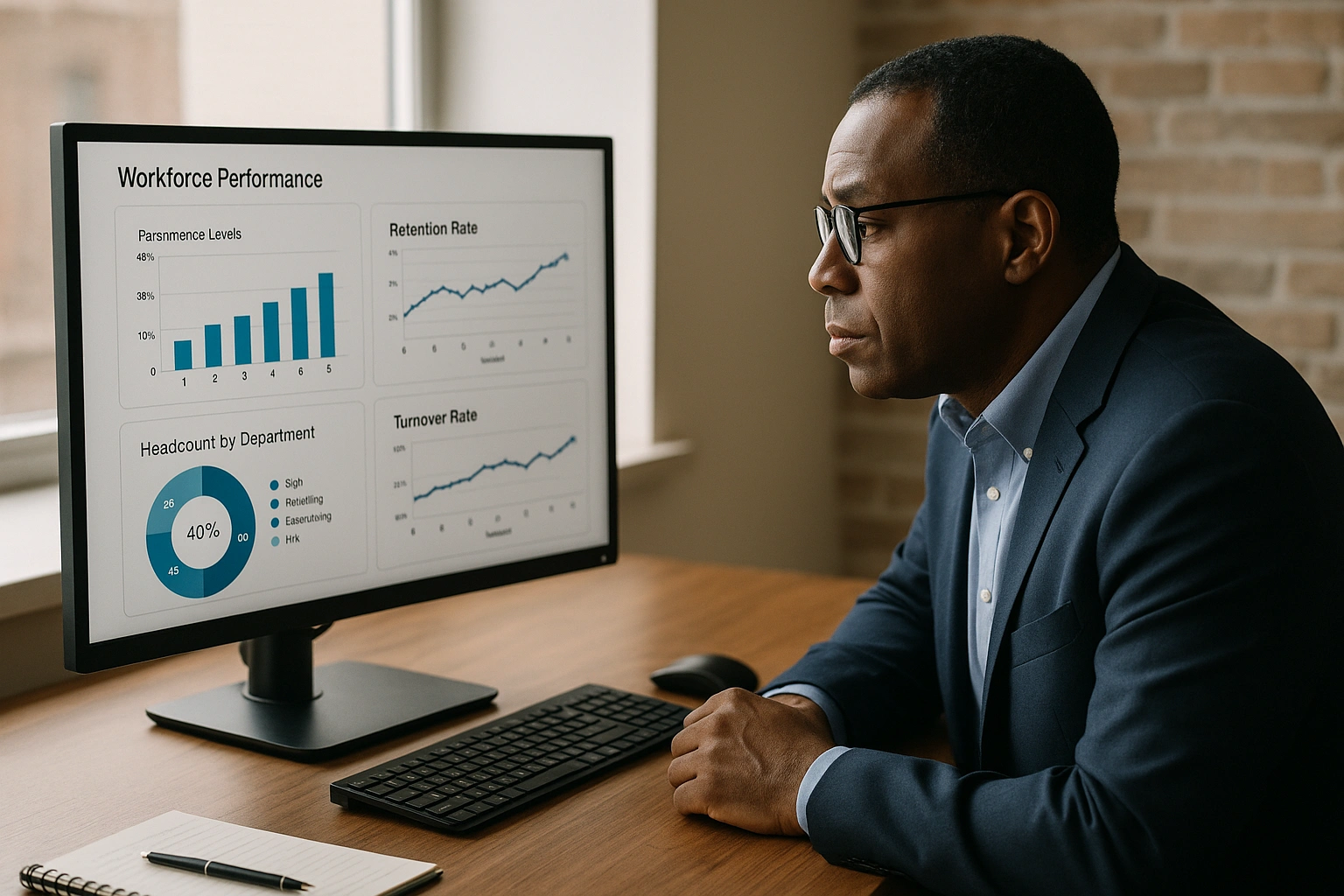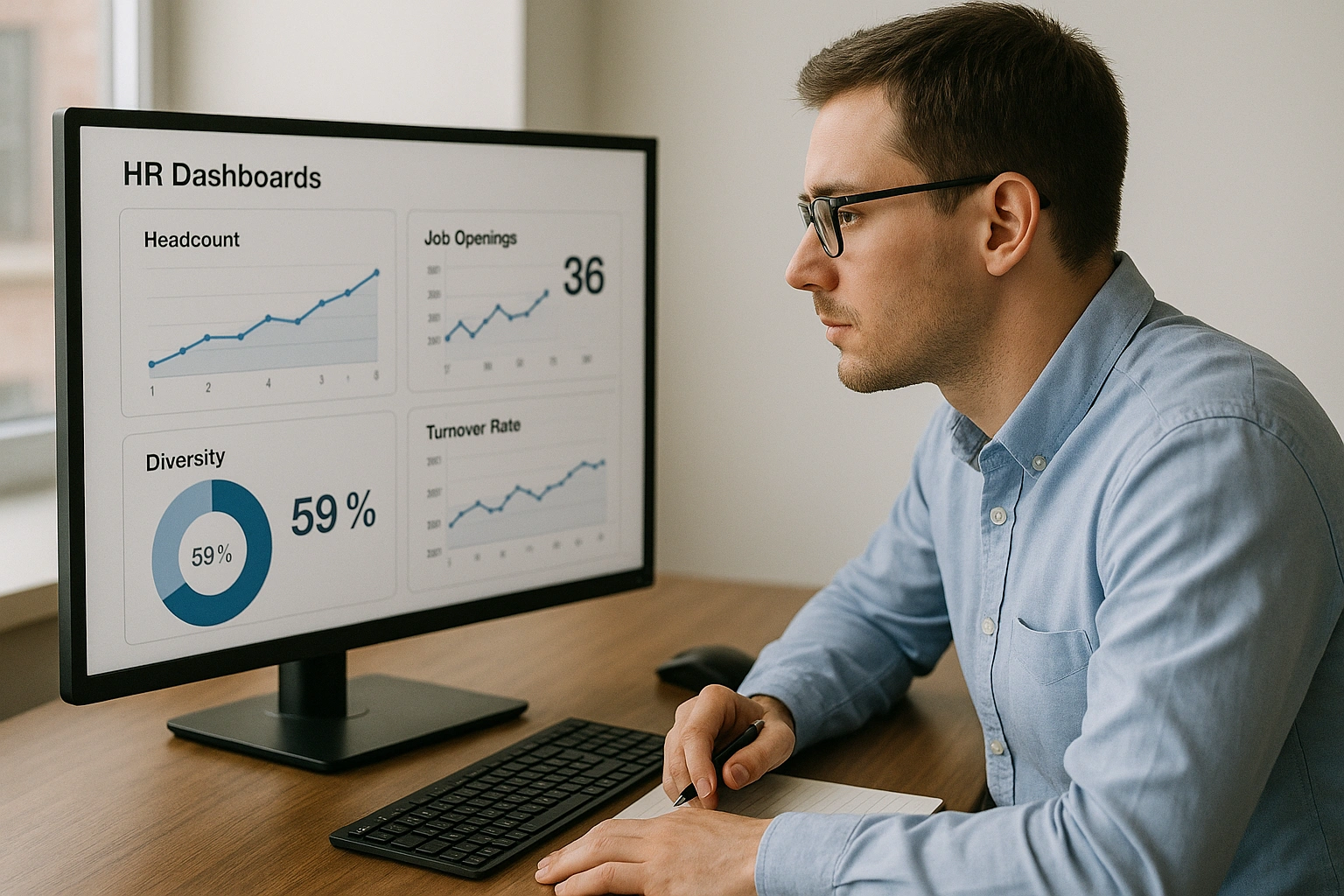
Imagine this, your company’s HR dashboard glows with metrics turnover rates, engagement scores, predicted resignations. Every number looks neat, until one morning your best team quits. Did your “workforce GPS” fail to warn you, or were you driving on autopilot?
That’s the paradox of modern HR analysis. It promises control and foresight yet sometimes leaves us wondering who’s truly in charge, the human or the algorithm. I stand on the side of AI: used thoughtfully, HR analysis is the GPS guiding HR from intuition to intelligent strategy, not a system that strips away judgment.
What “HR analysis” Really Means in Today’s Workforce

For decades, HR decisions were powered by gut instinct and anecdotal evidence. Today, data replaces guesswork. HR analysis means systematically using workforce data to understand, predict, and improve employee performance and organizational outcomes.
It combines :
- Data collection: from HRIS, engagement platforms, performance reviews.
- Modeling: applying AI or statistical tools to uncover patterns.
- Visualization: dashboards that make insights clear.
- Action: turning patterns into strategic decisions.
In other words, HR analysis translates workforce signals into strategic foresight.
Workforce GPS: How HR analysis Empowers HR and Leaders
When done right, HR analysis acts as a GPS providing navigation, not command. Predictive models reveal who might leave, which teams burn out, or where skill shortages will appear before they cause damage.
Benefits of predictive HR:
- Early detection of flight risks.
- Accurate talent forecasting.
- Smart succession planning.
- Skills gap mapping for future readiness.

Aligning HR with Business Strategy
C-suites don’t want reports; they want outcomes. HR analysis links talent metrics directly to business KPIs productivity, revenue, customer satisfaction, innovation.
By aligning HR with strategy:
- Recruiting becomes faster and targeted.
- Workforce costs align with growth plans.
- Employee engagement ties directly to profitability.
Harvard Business Review notes that data-driven HR correlates strongly with business performance and resilience (HBR on people analytics).
Autopilot to Nowhere: The Dangers of HR analysis Gone Wrong
Over-Reliance on Metrics: When Machines Drive People Decisions
The dark side of analytics emerges when leaders forget context. Over-indexing on numbers can reduce people to data points. Employees risk being labeled “low potential” by opaque algorithms, reinforcing bias and mistrust.
Warning signs of autopilot HR:
- Blind faith in dashboards without validation.
- Reduction of human potential to binary metrics.
- Lack of qualitative data from interviews or feedback.
Innovation vs. Regulation: When Analytics Outruns Ethics

Every innovation has a threshold. HR analysis must balance progress with responsibility. Algorithms that predict burnout, absenteeism, or “cultural fit” walk a fine line between insight and intrusion.
MIT Technology Review and Wired both highlight ethical pitfalls in algorithmic HR; from privacy breaches to unintended bias (MIT Tech Review on AI bias).
Read also: Talent-in-Q: AI for Hiring Managers
Designing HR analysis as a Strategic Tool Not Autopilot
Data Architecture and Talent Intelligence Foundation
Without clean data, even the best analytics engine misleads.
To build strong HR analysis:
- Consolidate data from HR systems into a single repository.
- Define consistent data models and taxonomies.
- Set governance rules for data privacy and retention.
- Train HR teams in analytics literacy.
ResearchGate study on AI-Powered Workforce Analytics
Decision-Making Frameworks and Human in the Loop
AI should assist, not replace, HR judgment. The best companies blend algorithmic insights with empathy, creating “augmented decisioning.”
HR Analytics Decision Framework
| Stage | Key Action | Responsible Role | Example Metric |
| Data Collection | Integrate HRIS and survey data | Data Engineer | Data completeness (%) |
| Modeling | Build predictive attrition models | Data Scientist | Model accuracy (%) |
| Review | Interpret insights with managers | HRBP | Insight adoption rate |
| Action | Implement policy or training | HR Leader | Retention uplift (%) |
| Feedback | Track results, retrain model | Analytics Lead | Performance delta |
Ethical Guardrails and Trust in HR analysis
Data builds credibility only when employees trust it. That means transparency, fairness, and consent must be embedded from design to deployment.
Checklist for trustworthy analytics:
- Explain why data is collected and how it will be used.
- Share aggregated insights instead of exposing individuals.
- Conduct regular bias audits and publish findings.
- Allow employees to challenge or correct data points.
Internal link: Vibe-in-Q: Measure Social Climate in Real Time

Proof Points and Metrics That Matter
Data is persuasive only when it proves value.
Recent studies show that organizations with advanced HR analysis outperform peers in retention, cost efficiency, and innovation.
Impact of HR analysis on Business Metrics
| KPI | Traditional HR | Data-Driven HR | Improvement |
| Employee Retention | 68% | 82% | +14 pts |
| Time-to-Hire | 45 days | 27 days | 40% faster |
| Employee Engagement | 61% | 78% | +17 pts |
| HR Operational Cost | 100% baseline | 85% | –15% |
Sources: McKinsey Workforce Analytics Report 2024; BCG People Data Study; Deloitte Human Capital Trends.

ScienceDirect study on HR analytics and organizational creativity
Final Verdict: Embrace the GPS, Disable the Autopilot
Data without direction is noise. HR analysis is only as good as the people interpreting it. Used responsibly, it helps leaders navigate uncertainty, personalize employee growth, and build resilient organizations.
Key takeaways for modern HR leaders:
- Treat analytics as guidance, not command.
- Balance automation with empathy.
- Keep human accountability central.
- Evolve from descriptive to predictive and prescriptive insights.
- Build a culture of data literacy and shared trust.
Read also: AI for HR : Revolutionizing HR with Intelligent Solutions
What is HR analysis and why is it essential?
It’s the practice of using data and analytics to understand and improve workforce performance. It replaces guesswork with measurable insights, improving agility and decision quality.
Can HR analysis replace human judgment?
No. It enhances judgment by filtering noise and highlighting priorities. The best outcomes come from AI-assisted decisions guided by human values.
How can HR teams start adopting analytics?
Start small: automate dashboards, track turnover, experiment with predictive models, and gradually expand into strategic forecasting.
What are the risks of relying too much on analytics?
Bias, overfitting, and detachment from human nuance. Always combining data with dialogue.
How do we ensure ethical HR analysis?
Use transparent communication, informed consent, fairness audits, and bias testing. Make sure every insight serves people not just profit.
Further Reading and Sources
- Harvard Business Review – The People Analytics Revolution
- MIT Technology Review – AI Bias in HR Systems
- ScienceDirect – HR Analytics and Organizational Creativity
- ResearchGate – AI-Powered Workforce Analytics for HR Optimization
Conclusion
The future of HR belongs to those fluent in data but grounded in empathy. HR analysis is the compass that keeps organizations oriented toward growth, fairness, and foresight. Refuse the autopilot; drive the journey yourself.



